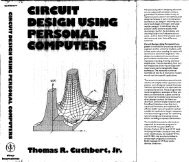IEEE New Jersey Coast Section Centennial Journal Part - GHN
IEEE New Jersey Coast Section Centennial Journal Part - GHN
IEEE New Jersey Coast Section Centennial Journal Part - GHN
You also want an ePaper? Increase the reach of your titles
YUMPU automatically turns print PDFs into web optimized ePapers that Google loves.
could be used outdoors."<br />
Further, Baker sees the opportunity to observe the behavior<br />
d molecules in space as affording what he calls "a new test tube<br />
br science. ln these vast spatial reactors, molecular collisions<br />
le occurring orders of magnitude slower than they have ever<br />
leen observed on earth-they are meters apart. So you have a<br />
nodel, magic situation where pair collisions take long times, you<br />
can observe the individual orientation of the molecules in space;<br />
rtd these are just the things we want to know in studying the<br />
rtability of the hardware of the Bell System, in studying ways to<br />
rake new components, in studying the interaction of charges<br />
rrd molecules in the electronics and circuitry of the System.<br />
3o here is a whole new game."<br />
A whole new game some 40 or more years after Karl Jansky's<br />
fscovery; the frail young man's legacy to Bell Laboratories, to<br />
and to the world was large indeed.<br />
-bnce,<br />
Merry-go-round, ln the early 1930s, Karl Jansky built this<br />
rotating radio antenna to document sources of<br />
statlc on transatlantic telephone lines.<br />
Jansky with the rotatable antenna he<br />
used in studies ol atmospheric noises<br />
that interfered wilh overseas radio telephone<br />
service. Among the noises, in 1933, he<br />
discovered a mysterious one coming<br />
from the center ol the Milky Way. His<br />
discovery led to the new science of radio<br />
astronomy.

















